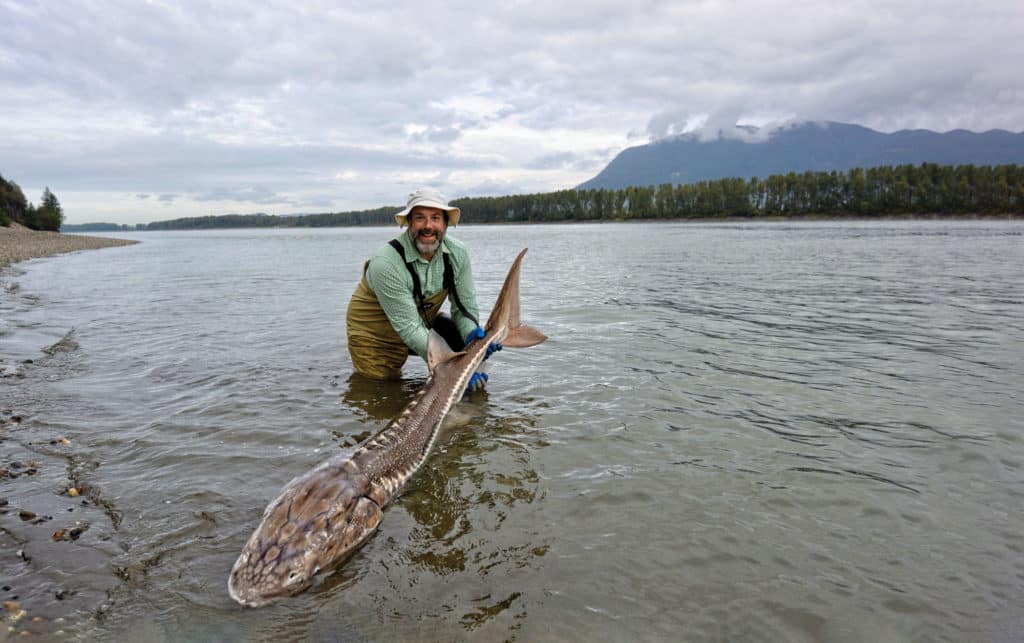
The slight twitch of my rod tip barely registered as a bite.
In fact, the word “bite” doesn’t seem accurate. It felt more like the 8-ounce sinker shifted position on the bottom. “The bite is going to be subtle,” Capt. Dave Eng had warned me. Subtle, it turned out, was an understatement. Yet that slight twitch indicated the sucking bite of a sturgeon and the prelude to a struggle.
Once hooked, there was nothing subtle about the sturgeon’s resolve. This was a fight, a tractor pull with a dinosaur.
It wasn’t a monster, but it was a sturdy fish, a determined fish, a fish that challenged me.
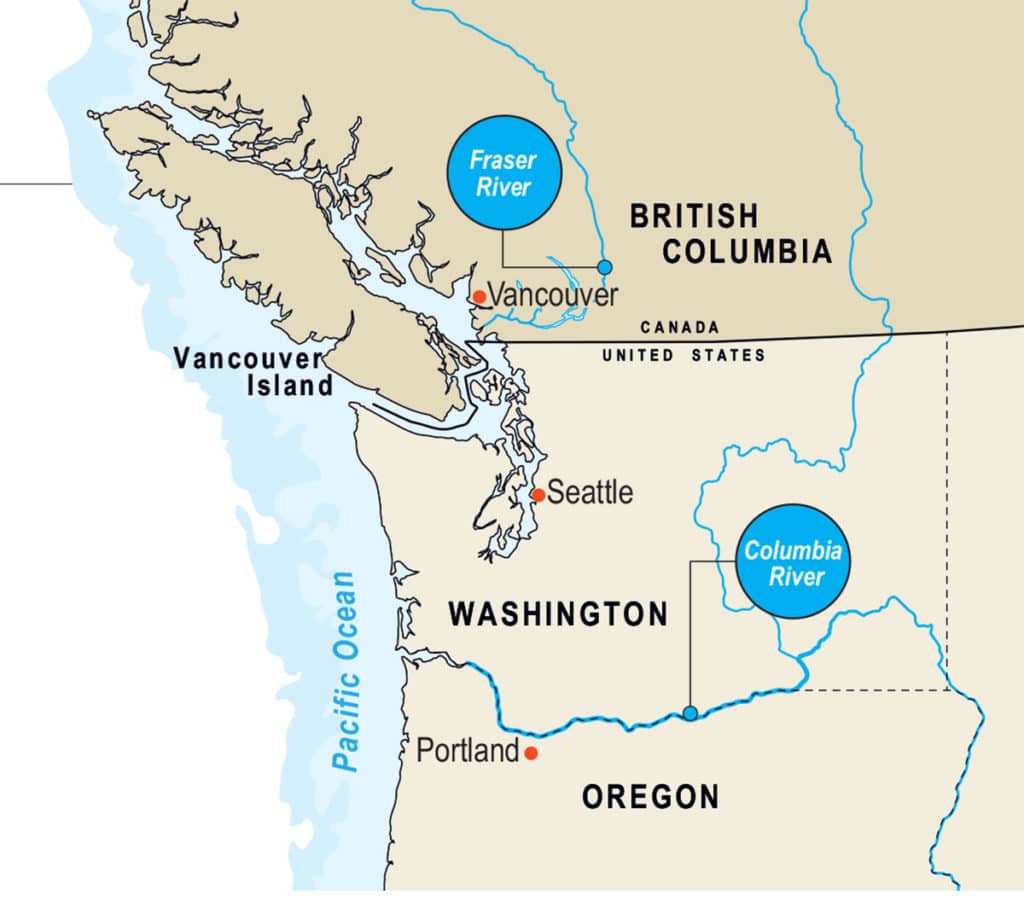
We were fishing just south of the Abernathy Bridge on Oregon’s Willamette River, where sturgeon of 6 to 8 feet are always a possibility. But I was thrilled with my 3 1/2-footer.
I’ve been fascinated by sturgeon for a long time, but Gulf sturgeon in my home waters of Florida’s Big Bend are a federally listed species and off-limits to fishing. So, I looked elsewhere to fulfill my Jurassic angling fantasy, and my attention fell on the Pacific Northwest.
The San Francisco Bay Estuary, San Pablo Bay and Suisun Bay are prime spots in California, as are the piers in San Francisco Bay and Humbolt Bay. Likewise, the bays of Oregon and Washington—Coos Bay, Tillamook Bay and Willapa Bay—as well as the area west of the Astoria Bridge at the mouth of the Columbia River, including Youngs Bay, are all considered prime sturgeon areas.
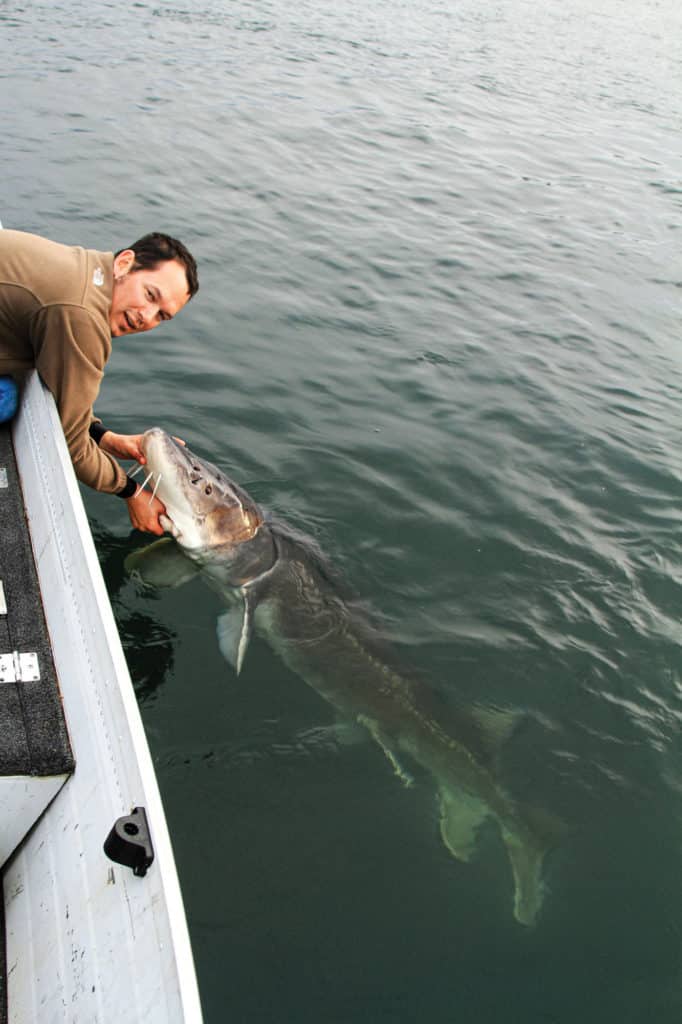
Columbia River White Sturgeon
For the best shot at a genuine monster, the Fraser River, just over the border in British Columbia, traditionally produces oversize fish on a regular basis.
Capt. Steve Talmadge has been fishing for sturgeon in the San Francisco Bay area for more than 40 years. “Of all the fish we target,” he says, “sturgeon are the most challenging, the most unpredictable.”
The Gear
Sturgeon demand gear that signals the slightest bite, then handles a muscular battle. Experts like Talmadge and Capt. Steve Mitchell of Vallejo, California, rely on rods built by Phenix out of Bellflower, California.
They look for rods in the 8-foot range with fast, sensitive tips to detect the subtlety of the bite. Sturgeon suck up the bait, crush it, spit it out, and then ingest the good parts. A rod that is sensitive to the initial and secondary vacuuming is crucial.
Both Mitchell and Talmadge choose conventional reels. Mitchell goes with a Penn Fathom loaded with 80-pound braid; Talmadge prefers Avet Reels SX and MXJ models with 50-pound braid. Sturgeon fishing requires dropping down baits and hauling in fish, not precision casting, so the key to reels in sturgeon fishing is strength rather than castability.
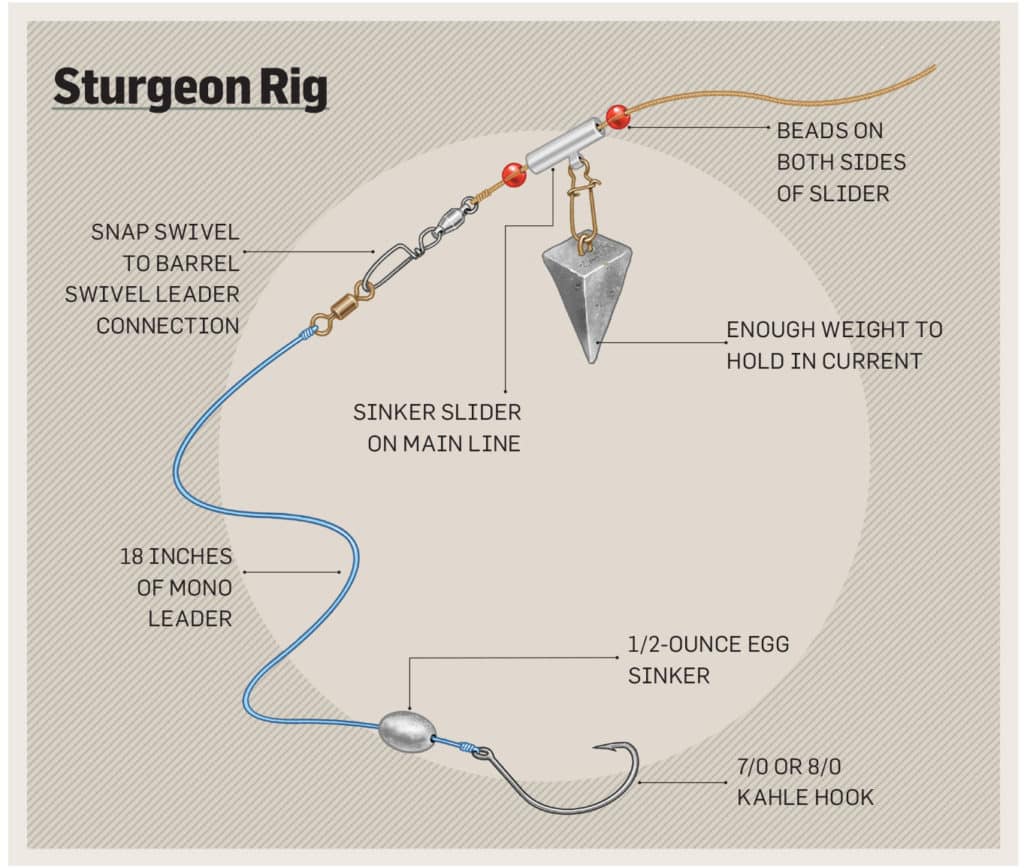
Slider rigs are the near-universal terminal tackle used for sturgeon. Most anglers use barbless 7/0 and 8/0 Kahle hooks rigged with a half-ounce of weight on some 18 inches of leader.
Above that, on a slider on the main line, a heavier sinker keeps baits on the bottom. Mitchell sometimes relies on 16 ounces or more to ensure the baits stay put in heavy current.
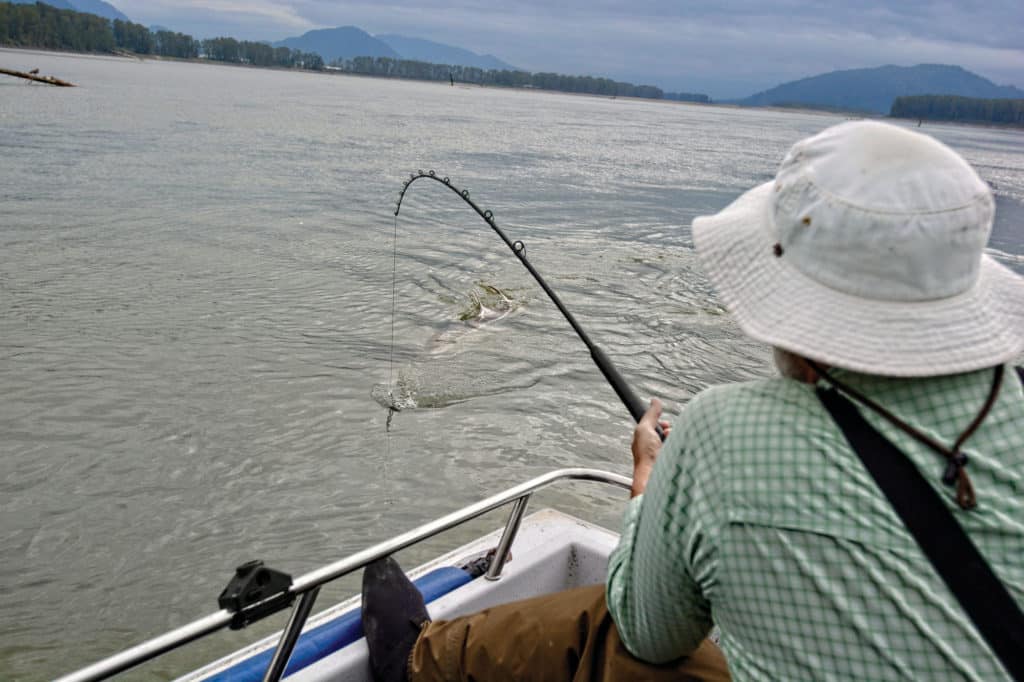
The Bait
Talmadge, whose logbooks go back to the 1970s, has found that the best bait changes each year. He and other sturgeon aficionados agree, though, that chunks of lamprey, king salmon roe, smelt, shad, grass shrimp, mud shrimp and ghost shrimp produce consistently. Night crawlers are also a popular bait, and some avid sturgeon anglers swear that combining smelt and night crawlers on a hook makes the ideal sturgeon candy.
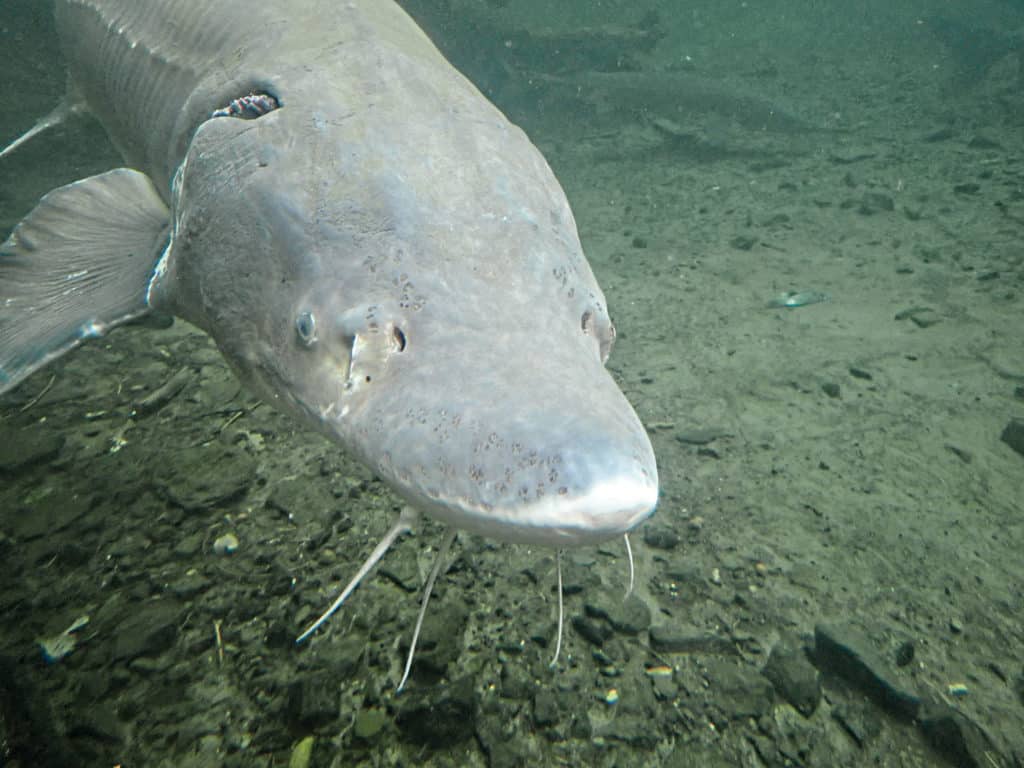
Sturgeon have poor eyesight and depend on scent to locate their food. They also pick up minute electrical fields on their lateral lines and around their heads, and are sensitive to sound.
Grass shrimp and some other baits emit small electrical fields, and sturgeon detect those as they scavenge the bottom. But it’s the scent that really attracts them, so a consistent trail is crucial to drawing sturgeon to a bait.
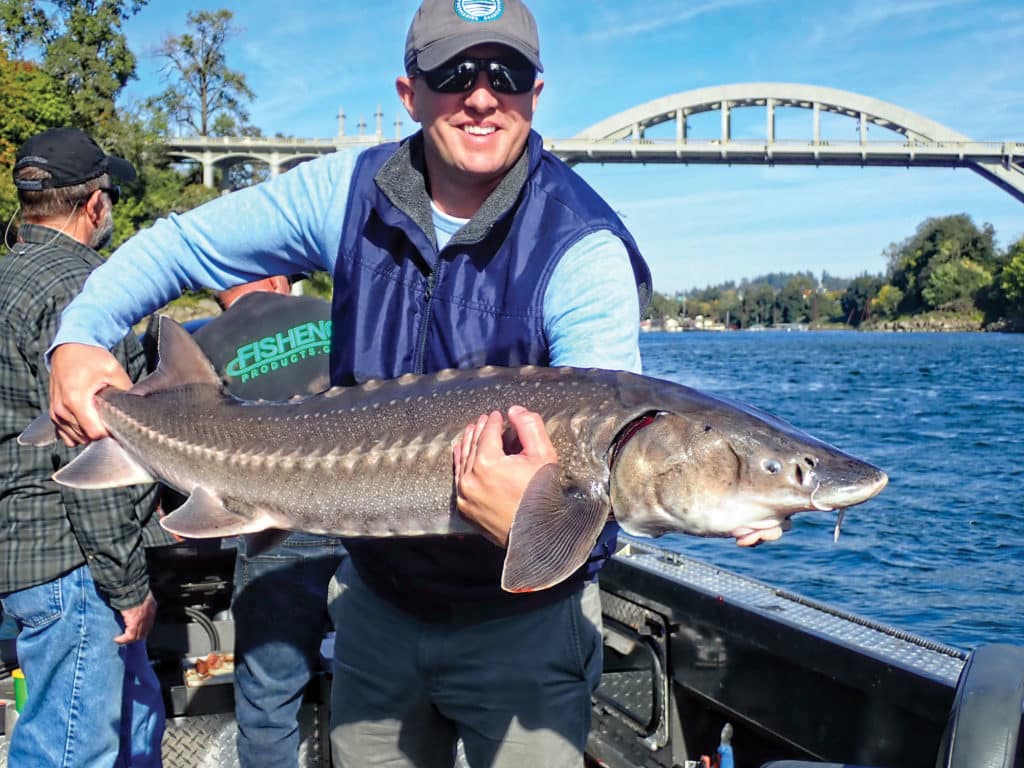
The Strategy
If there is truth in the adage that fishing requires patience, then sturgeon fishing truly tests the angler’s longanimity. The strategy for sturgeon fishing is to get your baits on the bottom and keep them there. Then wait.
Once the bait is down and dispersing scent, the fish locates the trail, follows it back to the bait, and vacuums it up. The hook-set required is a steady lift of the rod tip, followed by line retrieval. If you don’t feel the weight of the fish—which could take a bit of focus because the weight and the current might already be heavy—or if your rod tip isn’t fluttering when you lift it, slowly let the bait fall back to the bottom. Because the sturgeon is sucking and spitting the bait, if you miss the hookup and do not create commotion with a sudden, jolting action, the sturgeon is likely to follow the scent back to the bait and pick it up again. Unlike many other gamefish, a sturgeon doesn’t take the bait and swim away; it is more likely to linger with the bait in its mouth, determining whether to swallow or spit it out.
Read Next: How to Fish for Bottomfish
Once hooked, smaller sturgeon come to the surface easily, often barrel rolling and wrapping themselves in the line. Larger sturgeon won’t roll as much, but swim with the diligence of a boulder toward the bottom and cover.
Ultimately, sturgeon fishing first challenges patience, then one’s skills, and finally the mettle of your gear. Yet it also provides an opportunity to connect with one of the oldest living fishes on the planet, a true dinosaur.
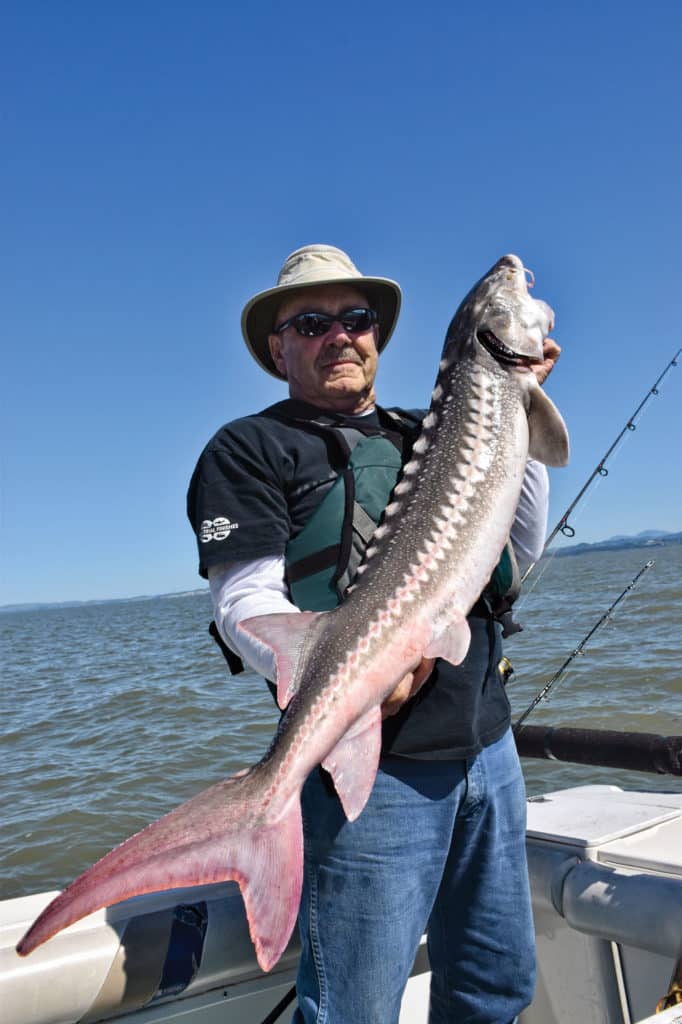
SWS Planner
An anadromous species, sturgeon move into estuaries and ascend rivers on the West Coast to spawn, providing fishable populations from San Francisco Bay north. History records show they are capable of growing to 20 feet, though modern catches average 4 feet or less. WHAT White sturgeon
Where: Pacific coastal waters, from the Fraser River in British Columbia, Canada, to San Francisco Bay, California
When: Spring through fall; check local regulations
Who: Let the experts put you on fish:
Eagle Creek, Oregon
Dave’s Fishing Guide Service
503-341-8863
San Francisco Bay and California Delta
Capt. Steve Talmadge
Flash Sport Fishing Charters
510-851-2500
Capt. Steve Mitchell
Hook’d Up Charters
707-655-6736
SWS Tackle Box
Rods: Conventional 8-foot, beefy enough to handle heavy fish, with a sensitive tip to pick up delicate strikes
Reels: Conventional, such as Penn Fathom, Avet SX and MXJ, or equivalent
Line: 50- to 80-pound braid
Bait: Lamprey chunks, king salmon roe, smelt, shad, grass shrimp, mud shrimp, ghost shrimp
Rigs: Sliding rig with enough weight to hold in the current, 7/0 to 8/0 barbless Kahle hooks
Other: Check local and state regulations and seasons, which vary
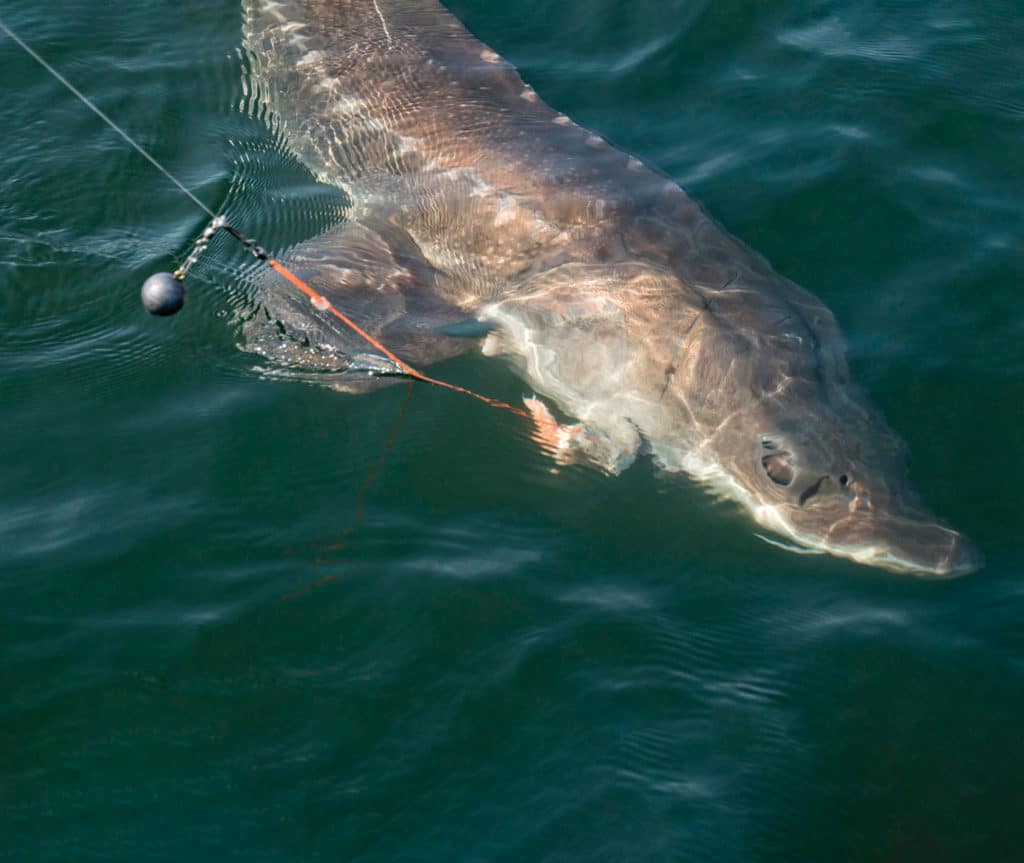
Sturgeon Fishing on the Columbia River near The Dalles, Oregon.
Prehistoric Mysteries
Historically, white sturgeon (Acipenser transmontanus) ranged from Ensenada, Mexico, to the Gulf of Alaska. The largest modern concentrations are in San Francisco and San Pablo bays in California, the Columbia River, and the Fraser River drainage in British Columbia. The fish forage in bays and estuaries, but are known to travel offshore to water as deep as 50 fathoms. Sturgeon are anadromous, meaning they feed and grow in salt water and spawn in fresh water, though some populations spend their entire lives in fresh water.
For anglers’ purposes, they are generally sought in their spawning rivers. The largest white sturgeon recorded was 20 feet long, but they more commonly measure 7 feet or less. The heaviest recorded specimen weighed 1,799 pounds, a fish that was determined to be 104 years old.
The current California state-record sturgeon is a 468-pounder caught in San Pablo Bay. On the other end of their sport-fishing range, a fish estimated at 890 pounds was caught and released in August on the Fraser River. Sturgeon are highly regulated, and sport-fishing rules vary from river to river and change frequently, often midseason.









